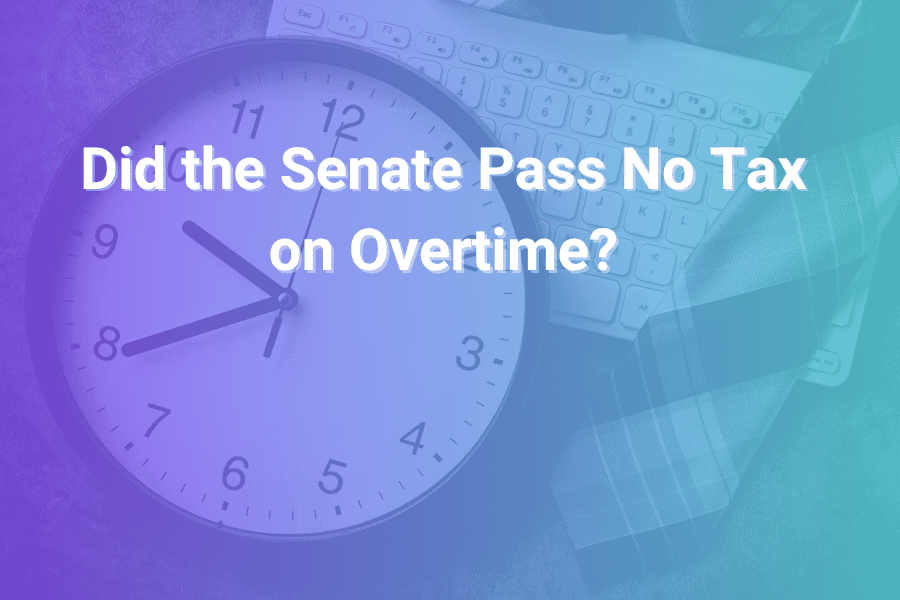
Many Americans are asking: did the Senate pass “no tax on overtime”? As legislators scramble to deliver tax relief, the proposal to exempt overtime earnings from federal income tax grabbed attention.
In this article you’ll learn the legislative status, what “no tax on overtime” would do, who qualifies, major objections, and next steps in Congress. in this article
What Is the “No Tax on Overtime” Proposal?
Under current law, every dollar earned—regular or overtime—is treated as gross income and taxed accordingly. The “No Tax on Overtime Act of 2025” (Senate Bill 1046) proposes to change that.
It would amend the Internal Revenue Code so overtime compensation required under the Fair Labor Standards Act (FLSA) no longer counts toward taxable income. Effectively, workers could deduct qualified overtime from their federal income tax base. (Congress.gov)
That said, the proposal applies only to overtime “required under section 7 of the FLSA”—meaning hours worked beyond 40 in a week for nonexempt employees. (Congress.gov)
Legislative Status: Did the Senate Actually Pass It?
Short answer: Not in that plain form.
- S. 1046 was introduced March 13, 2025, by Senator Josh Hawley and referred to the Senate Finance Committee. It never advanced beyond that committee (i.e. no vote on the Senate floor). (Congress.gov)
- The bill remains “introduced”—it hasn’t passed the Senate as a standalone act. (LegiScan)
- Meanwhile, the House has embedded a version of “no tax on overtime” in a larger reconciliation package known as the One Big Beautiful Bill Act (often called OBBBA). (CUPA-HR)
In short: the Senate hasn’t passed S. 1046 alone. But something akin to its provisions made it into the final mega-bill that the Senate did approve.
How “No Tax on Overtime” Survived Inside the Big Bill
When the Senate took up OBBBA, it adopted a version of the overtime-tax relief concept, though with modifications. The bill passed the Senate on July 1, 2025 (51–50, tie broken by the Vice President). (Wikipedia)
Inside OBBBA:
- Workers may deduct qualified overtime up to $12,500 for individual filers (or $25,000 for joint filers). (Wikipedia)
- The deduction phases out for single filers with modified adjusted gross income (MAGI) above $150,000 and married filers above $300,000.
- It’s available only 2025 through 2028.
- The deduction is for federal income tax only—Social Security and Medicare taxes still apply.
- For the 2025 tax year, Form W-2 and other reporting rules remain unchanged; overtime tracking is required to support deductions when filing.
So yes: the Senate ultimately approved a version of “no tax on overtime,” but not via S. 1046 as originally drafted.
Who Qualifies—and Who Doesn’t
Not every worker gets this benefit. Key rules:
- Must be nonexempt under FLSA (i.e. eligible for overtime).
- Overtime must be the kind required by FLSA (beyond 40 hours/week). Voluntary or bonus overtime outside that context may not qualify. (Wikipedia)
- Must have MAGI below threshold ($150,000 single; $300,000 married).
- Only the “premium” portion (the half-time extra) counts, not the entire overtime earnings. (Wikipedia)
- The deduction applies to income tax, not payroll taxes (FICA).
- Deduction period limited: 2025 to 2028.
- Employers must report overtime amounts on W-2s (or approximate for 2025). (Wikipedia)
Projected Impact & Recent Data
Supporters claim it delivers real relief to middle-income workers, especially service or shift workers who commonly work overtime. Some sources suggest the deduction could reduce income tax liabilities for many.
On potential cost: critics estimate the loss in federal revenue could hit hundreds of billions over a decade. For instance, Yale’s Budget Lab projects that exempting overtime might cost $866 billion over ten years, or more if payroll taxes were also exempted. (issuevoter.org)
One Newsweek article notes the Senate version limits the “no tax on overtime” relief to a $12,500 deduction and pairs it with a similar tips deduction, both phasing out at income thresholds. (Newsweek)
Arguments in Favor & Criticisms
Pros:
- Workers get to keep more of extra effort without extra tax bite.
- Encourages overtime, possibly boosting productivity.
- Delivers on campaign promises about tax relief for working Americans. (Senator Justice)
Cons:
- Revenue loss amid high deficits. (issuevoter.org)
- Adds complexity to tax and payroll systems, especially distinguishing qualifying overtime. (issuevoter.org)
- It might create tax inequities: workers with identical income but different income composition (overtime vs salary) could face different tax burdens. (issuevoter.org)
- Could encourage overwork or gaming of overtime rules.
- Phase-out thresholds may limit benefit for many middle-income earners.
What Happens Next in Congress
Having passed the Senate within OBBBA, the measure must now survive reconciliation between the House and Senate. While the House already had its own version, revisions may occur. (CUPA-HR)
Stakeholders will contest thresholds, enforcement, reporting, and exemptions. The IRS must issue guidance, especially for 2026 reporting.
Watch for:
- Final negotiated language (Senate vs House)
- IRS and Treasury rulemaking
- Clarification on payroll withholding vs year-end deduction
- State law interactions (some states have stricter overtime rules)
Conclusion:
Strictly speaking: no, the Senate never passed S. 1046 in isolation. But yes, the concept—modified—passed via the Senate’s version of the One Big Beautiful Bill Act, which includes a “no tax on overtime” deduction. That version is now subject to final reconciliation and executive review.
If you like, I can produce a timeline chart or a simplified “if this passes, here’s how it works” guide. Want me to make that?
